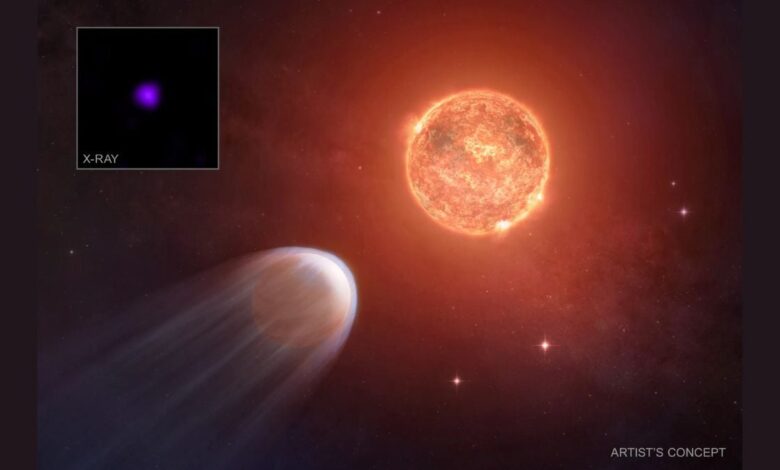Young Exoplanet Loses Atmosphere to Star’s Radiation

Baby Exoplanet’s Atmospheric Escape: A Cosmic Drama
NASA’s Chandra X-ray Observatory and the Hubble Space Telescope have teamed up to witness a fascinating phenomenon: a young exoplanet, named TOI 1227 b, rapidly losing its atmosphere under the intense radiation of its host star. This observation provides a rare glimpse into the dynamic processes that shape planetary evolution in the early stages of a solar system’s life.
TOI 1227 b: A Planet Under Siege
TOI 1227 b is a Jupiter-sized exoplanet orbiting a faint red dwarf star. What makes this planet particularly interesting is its age – a mere 8 million years old, making it a cosmic infant compared to Earth’s 4.5 billion years. The proximity of TOI 1227 b to its star, much closer than Mercury is to our Sun, exposes it to extreme levels of X-ray radiation.
This intense radiation is stripping away the planet’s thick gaseous atmosphere at an alarming rate. Scientists estimate that TOI 1227 b is losing an amount of gas equivalent to Earth’s entire atmosphere approximately every 200 years. This atmospheric erosion is so significant that the planet’s future is uncertain.
Observing the Atmospheric Erosion
Astronomers utilized Chandra’s X-ray data, along with earlier Hubble observations of the planet’s transit, to study this atmospheric escape in detail. The observations reveal a dramatic scene: a blue tail of gas streaming away from TOI 1227 b, visually representing the planet’s atmosphere being torn apart by stellar radiation.
Computer simulations support these observations, indicating that the intense radiation will “rapidly” strip away the gas. The long-term consequences could be drastic. If the current conditions persist, TOI 1227 b could transform from a gas giant into a smaller, barren world, potentially losing its entire atmosphere and becoming a rocky core.
The Role of Stellar Radiation in Planetary Evolution
This discovery highlights the crucial role that stellar radiation plays in the evolution of young planetary systems. High-energy X-rays and ultraviolet light emitted by active young stars can significantly impact a planet’s atmosphere. This process, known as photoevaporation, can heat and blow away a planet’s atmosphere, potentially altering its size, composition, and overall habitability.
Photoevaporation: A Hair Dryer on an Ice Cube
As Joel Kastner, co-author of the study, aptly describes it, the star’s radiation acts like “a hair dryer on an ice cube,” gradually eroding the planet’s atmosphere. This photoevaporation process is believed to be a key factor in explaining why many intermediate-sized exoplanets end up smaller or stripped down to their rocky cores.
Implications for Understanding Exoplanets
The study of TOI 1227 b provides valuable insights into the processes that shape exoplanets during their formative years. Understanding the impact of stellar radiation on planetary atmospheres is crucial for accurately characterizing exoplanets and assessing their potential for habitability.
Future Research Directions
Further research is needed to fully understand the complex interplay between stellar radiation and planetary atmospheres. This includes:
- Developing more sophisticated models of atmospheric escape.
- Conducting more observations of young exoplanets in various stages of atmospheric erosion.
- Investigating the role of planetary magnetic fields in protecting atmospheres from stellar radiation.
Table: TOI 1227 b Key Characteristics
| Characteristic | Value |
|---|---|
| Planet Name | TOI 1227 b |
| Host Star Type | Red Dwarf |
| Planet Age | ~8 million years |
| Atmospheric Loss Rate | Earth’s atmosphere every ~200 years |
| Observation Methods | Chandra X-ray Observatory, Hubble Space Telescope |
By continuing to study exoplanets like TOI 1227 b, scientists can gain a deeper understanding of the diverse and dynamic processes that shape the universe and the potential for life beyond Earth.




